Saturday, April 28, 2007
Wednesday, April 25, 2007
Am I Yee Wei, who woke up from a dream in which I ate a goat, or am I a python dreaming I am surfing the web?
Which is real- the words, or the author?
I fly home on Saturday afternoon, and nothing has been packed.
The wedding is going to be interesting. The cousins have agreed to coordinate the colour of the clothes, hence expect a table full of pink and beige. Wickedness…
And my brother has secured the use of a huge Nikon SB-800 flashgun and a Canon EOS 650 camera body. Supplementing that to our existing collection of lenses, 3 camera bodies, a flashgun and suitable lens mount adapters, the extra body would help reduce time consuming lens changes.
On the basis of recommendations by 小李飞刀, I have laid my hands on a book by Lev Landau. It looks quite fantastic; the way in which he introduces special relativity is quite different from the typical SR text books.
The typical manner in which SR is introduced usually involves an experiment involving light bouncing around in a moving train. This tends to make (the speed of) light look like some kind of God-phenomenon that controlled the universe.
Landau did it the other way around, by introducing special relativity using an upper-limit on signal propagation velocities. And it turns out that electromagnetic radiation happens to ride on this very limit. The c that appears in the Lorentz-contraction is not explicitly the speed of light; it is the speed limit of signal propagation velocity.
Which is real- the words, or the author?
I fly home on Saturday afternoon, and nothing has been packed.
The wedding is going to be interesting. The cousins have agreed to coordinate the colour of the clothes, hence expect a table full of pink and beige. Wickedness…
And my brother has secured the use of a huge Nikon SB-800 flashgun and a Canon EOS 650 camera body. Supplementing that to our existing collection of lenses, 3 camera bodies, a flashgun and suitable lens mount adapters, the extra body would help reduce time consuming lens changes.
On the basis of recommendations by 小李飞刀, I have laid my hands on a book by Lev Landau. It looks quite fantastic; the way in which he introduces special relativity is quite different from the typical SR text books.
The typical manner in which SR is introduced usually involves an experiment involving light bouncing around in a moving train. This tends to make (the speed of) light look like some kind of God-phenomenon that controlled the universe.
Landau did it the other way around, by introducing special relativity using an upper-limit on signal propagation velocities. And it turns out that electromagnetic radiation happens to ride on this very limit. The c that appears in the Lorentz-contraction is not explicitly the speed of light; it is the speed limit of signal propagation velocity.
Tuesday, April 24, 2007
A quick investigation of bright M42 primes
This post shows the close-up abilities of several screw-mount prime lenses with the help of an extension tube. The main area of interest was full aperture depth of field and sharpness.
The photos show that in general, wide open eperture and extremely de-focussing results in a colour shift of bright lights. Bright sources on the far side of the focal plane appear to have a blue fringe around the edges while less obviously, bright sources on the near side appear to have a red fringe.
The standard and short telephoto give good closeup abilities and extremely shallow depth fields, thus providing the flexibility of varying the depth of field to suit. The telephoto (135mm) has a deeper depth of field due to its longer focal length and smaller aperture.
Test apparatus: lenses handheld over a Nikon D40. Sensor size is approximately APS-C and thus images here are do not give details of the edge behavior of the lenses.
Lenses tested: Super-Takumar 50mm f/1.4, Jupiter-9 85mm f/2.0, Super-Takumar 135mm f/3.5
The photos show that in general, wide open eperture and extremely de-focussing results in a colour shift of bright lights. Bright sources on the far side of the focal plane appear to have a blue fringe around the edges while less obviously, bright sources on the near side appear to have a red fringe.
The standard and short telephoto give good closeup abilities and extremely shallow depth fields, thus providing the flexibility of varying the depth of field to suit. The telephoto (135mm) has a deeper depth of field due to its longer focal length and smaller aperture.
Test apparatus: lenses handheld over a Nikon D40. Sensor size is approximately APS-C and thus images here are do not give details of the edge behavior of the lenses.
Lenses tested: Super-Takumar 50mm f/1.4, Jupiter-9 85mm f/2.0, Super-Takumar 135mm f/3.5

Super-Takumar 50mm f/1.4

Super-Takumar 50mm f/1.4 with extension tube, wide open

Super-Takumar 50mm f/1.4 with extension tube, stopped down to f/5.6
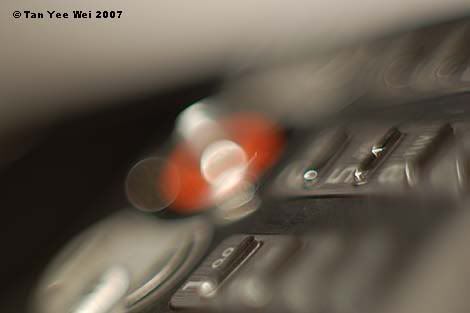
Super-Takumar 50mm f/1.4 with extension tube, wide open
Note the lens flare
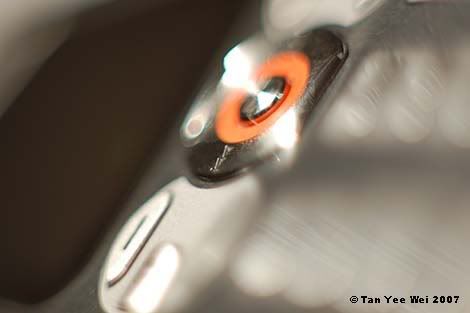
Super-Takumar 50mm f/1.4 with extension tube and lens hood, wide open
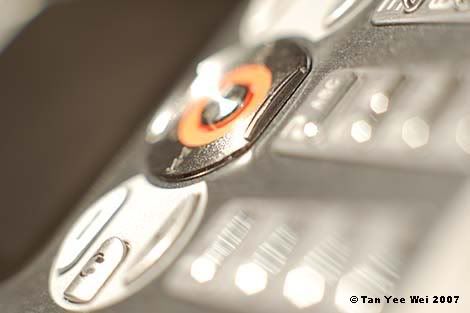
Super-Takumar 50mm f/1.4 with extension tube and lens hood, stopped down to f/4.0
Note the hexagonal bokeh.

Click here for large size image
Jupiter-9 80mm f/2, wide open

Jupiter-9 80mm f/2 with extension tube, wide open
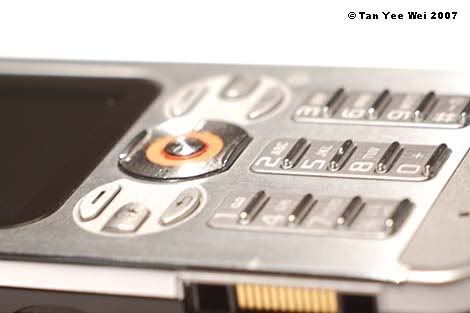
Click here for large size image
Jupiter-9 80mm f/2 with extension tube, stopped down to f/5.6

Super-Takumar 135mm f/3.5, wide open

Super-Takumar 135mm f/3.5 with extension tube, wide open
Labels: photographic equipment
Sunday, April 22, 2007
Extension tube
When I purchased the Cosina 19-35mm lens from Albert, he added a bonus in the form of a Hoya x2 teleconverter. Unfortunately, it was heavily infected by fungus and thus retained not much optical functionality.
Yesterday, I decided to turn the teleconverter into an extension tube. By taking out the optical elements, the teleconverter becomes an empty tube with male and female lens mounts at the ends – an extension tube.
After prying the optics away from the rear mounting ring, the extension tube performed as expected. However, the optical assembly also included various levers to set the light meter. Various attempts were made to restore the light metering lever, but all failed miserably.
Yesterday, I decided to turn the teleconverter into an extension tube. By taking out the optical elements, the teleconverter becomes an empty tube with male and female lens mounts at the ends – an extension tube.
After prying the optics away from the rear mounting ring, the extension tube performed as expected. However, the optical assembly also included various levers to set the light meter. Various attempts were made to restore the light metering lever, but all failed miserably.
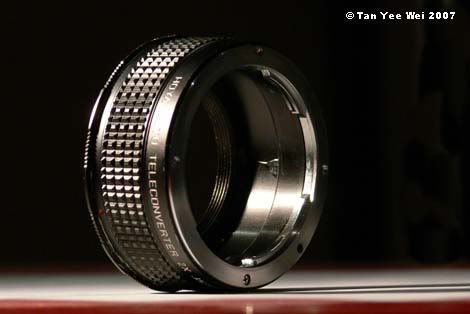
Finally, I gave up on retaining aesthetics. A faulty M42-K mount converter ring was attached to the tube to provide the K-mount interface and metering controls. It’s far uglier than using the shiny original aluminium bayonet mount, but it works better than a charm.
The results are startling:
Super-Takumar 50mm f/1.4, without extension tube
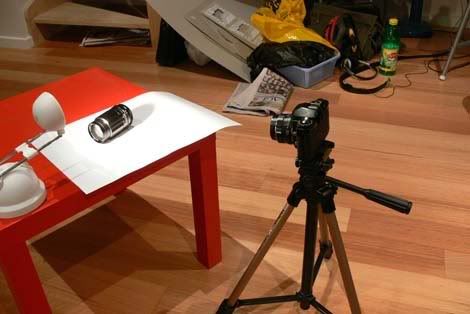
The camera at its closest focusing distance

And the view through the viewfinder
Super-Takumar 50mm f/1.4, with extension tube

With the extension tube, the focusing distance decreases dramatically
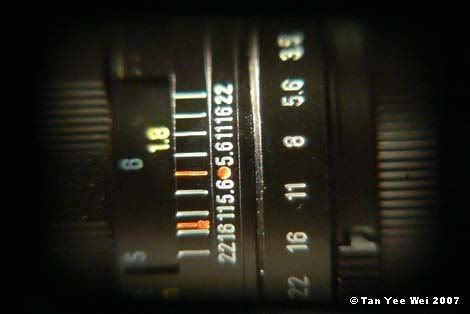
And the subject can be seen in much, much greater detail
Labels: photographic equipment
Friday, April 20, 2007

Click here for large size image
Super-Takumar 50mm f/1.4 lens with Fuji Superia 200 colour negative film
Compared to CCDs, the dynamic range of film is fantastic. Note the detail that remains visible in the clouds and the underside of the fuselage.
Labels: photographic equipment, photography
Thursday, April 19, 2007
Hoods are cool
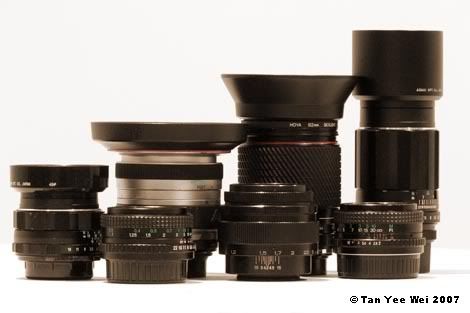
Click here for large size image
Monochrome sepia toned, then additional masked layer to restore coloured lens markings.
It's absurd, I know... 7 lenses! Who the hell uses 7 lenses... I don't- some are superseded by sharper, faster primes. The ones that will probably see most service are the super-wide 19-35mm, the ultra-fast 50mm 1.4 and the fast portrait 85mm 2.0.
Labels: photographic equipment, photography
Monday, April 16, 2007
There goes the weekend, pranced past in the multi-coloured blur of a magnificently huge dim sum brunch, cleaning and rearranging the house, endurance racing on GT3, time wasted waiting for late trams and idle time-wasting in general.
***
Tan Yee Wei asked me what I'm obsessed with:
I’m not tagging anyone.
Perhaps we should fleetingly introduce this confusing character who has the same name as me, the one who said, “Gah... my email's [address removed]. Now I know who took the other tanyeewei.” She’s female; I’m not.
The scope for daft jokes is quite vast.
***
On optical instruments, I received my recently ordered lenses, a Super Takumar 135mm f3.5 and a Jupiter-9 85mm f2.0.
Tan Yee Wei asked me what I'm obsessed with:
Knives
Optical instruments
GT3, for now
I’m not tagging anyone.
Perhaps we should fleetingly introduce this confusing character who has the same name as me, the one who said, “Gah... my email's [address removed]. Now I know who took the other tanyeewei.” She’s female; I’m not.
[truncated]
I’ll come over and marry you tomorrow
Haha
...
Nono, can’t do that
There’d be problems with the name
Yup
It will drive the guests mad
Haha
The bride and groom's sides will sit haphazardly
I think it will drive us nuts too
The scope for daft jokes is quite vast.
On optical instruments, I received my recently ordered lenses, a Super Takumar 135mm f3.5 and a Jupiter-9 85mm f2.0.
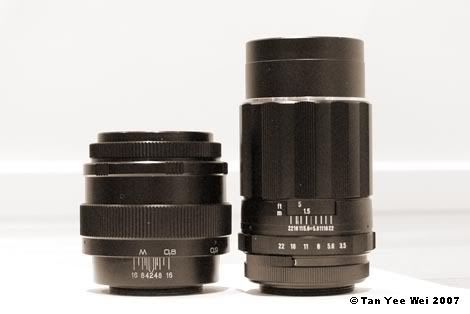
And there they are, the 85mm Soviet copy of the German Carl-Zeiss Sonnar, and the Japanese Super-Takumar 135mm. Note the minimum focal distances of 0.7 m and 1.5 m are closer than what most zoom lenses can give.
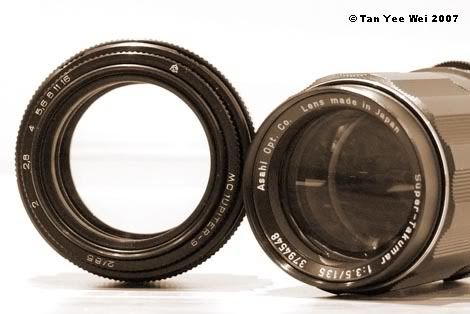
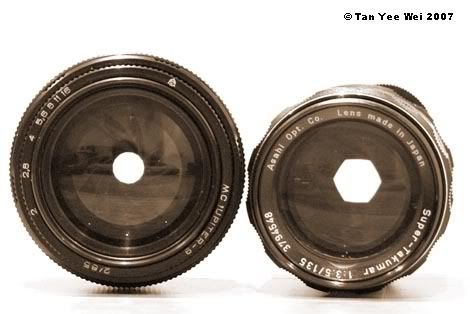
The Super-Takumar has six aperture blades (resulting in the hexagonal aperture when partially closed) while the Jupiter-9 has...
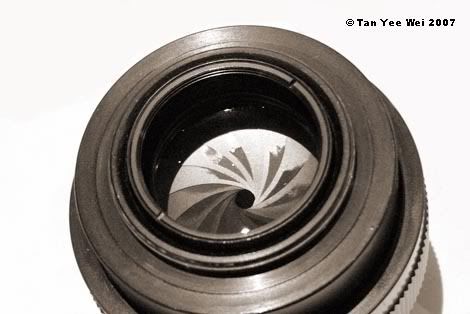
Ah yes, the Jupiter-9 has 16 aperture blades, resulting in a hexadecagon aperture. By the way, you will need your fingers and toes to count the aperture blades. Unless you are a male with three 5-fingered hands...
***
The first two minutes of the GT3 intro scene is superb. With various views into an operational engine block, it’s sure to get any petrol head’s blood running. I especially love the scene with the invisible engine block, pumping pistons, combusting fuel mixture and running cam shafts- it nearly always brings tears to my eyes, and I can watch it over and over again.
The first two minutes of the GT3 intro scene is superb. With various views into an operational engine block, it’s sure to get any petrol head’s blood running. I especially love the scene with the invisible engine block, pumping pistons, combusting fuel mixture and running cam shafts- it nearly always brings tears to my eyes, and I can watch it over and over again.
Labels: blogging, meme, mixed, personal, photographic equipment, photography
Thursday, April 12, 2007
Life as an engineer
Two interesting side effects are that my fingernails are probably getting stiffer, and my fingers are much stronger now.
The kitchen at the office has free flow of instant coffee, tea, sugar, Milo, instant hot chocolate and various varieties of milks (whole, low fat and no fat. No fat tastes revolting). As such, I take full advantage of getting continuous hits of caffeine throughout the day.
I usually make coffee by using just slightly more than enough hot water to dissolve the coffee granules, and top up with milk. Cold and milky is how I’ve been taking my coffee since the mid 90s.
Everyday, I’d have three to four cups of coffee at work. Including the cup I consume immediately after waking up, my daily milk consumption is slightly more than half a litre. Consequently, the finger and toenails have been getting their supply of nourishment.
The door leading to the male toilet is like a typical public toilet where one pushes on the door without needing to turn any knobs. I have taken to pushing on the doors with my fingers curled into a dome shape (not with the finger digit joints locked). Initially, the thumb had to do most of the work; now I can open the door quite rapidly using only the index and middle fingers.
Piss me off and I’ll spear you using my Iron Lance Fingers (铁枪指) technique.
Work has been quite interesting these days. The department has acquired a massive project from the United Arab Emirates, something to make a statement to the rest of the world. Grander than the KLCC project and more magnificent than the Burj-al-Arab (the world’s only 7-star hotel), this thing has been keeping the department busy for the past week and probably for the coming months.
Given a relatively free hand to work on a revolutionary project that requires non-standard solutions, I’ve been exercising some of my mathematical clout in engineering design. Bring on the topology, finite-state machines, invariance and geometric transformations!
The kitchen at the office has free flow of instant coffee, tea, sugar, Milo, instant hot chocolate and various varieties of milks (whole, low fat and no fat. No fat tastes revolting). As such, I take full advantage of getting continuous hits of caffeine throughout the day.
I usually make coffee by using just slightly more than enough hot water to dissolve the coffee granules, and top up with milk. Cold and milky is how I’ve been taking my coffee since the mid 90s.
Everyday, I’d have three to four cups of coffee at work. Including the cup I consume immediately after waking up, my daily milk consumption is slightly more than half a litre. Consequently, the finger and toenails have been getting their supply of nourishment.
The door leading to the male toilet is like a typical public toilet where one pushes on the door without needing to turn any knobs. I have taken to pushing on the doors with my fingers curled into a dome shape (not with the finger digit joints locked). Initially, the thumb had to do most of the work; now I can open the door quite rapidly using only the index and middle fingers.
Piss me off and I’ll spear you using my Iron Lance Fingers (铁枪指) technique.
Work has been quite interesting these days. The department has acquired a massive project from the United Arab Emirates, something to make a statement to the rest of the world. Grander than the KLCC project and more magnificent than the Burj-al-Arab (the world’s only 7-star hotel), this thing has been keeping the department busy for the past week and probably for the coming months.
Given a relatively free hand to work on a revolutionary project that requires non-standard solutions, I’ve been exercising some of my mathematical clout in engineering design. Bring on the topology, finite-state machines, invariance and geometric transformations!
Labels: personal
Tuesday, April 10, 2007
Microscopy: chilli slice and fly
Photos captured using a Panasonic FZ-30 with a reverse mounted Super-Takumar 50mm f/1.4 and a Vivitar 28mm f2.8. Stopped down, the Super-Takumar is absurdly sharp, as vividly demonstrated in the first fly images.
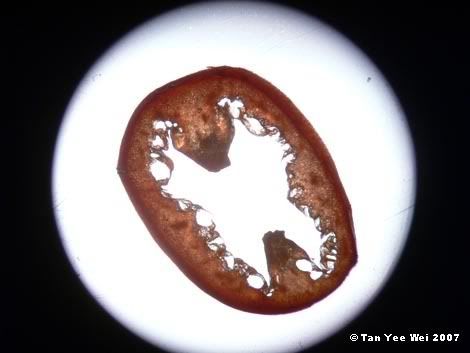
Click here for large size image
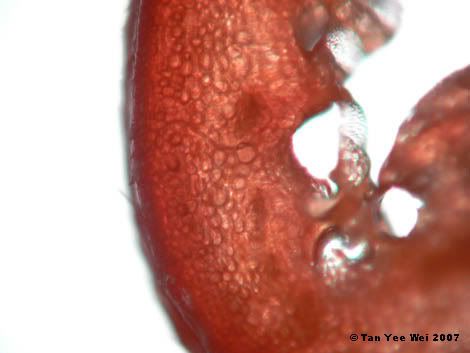
Click here for large size image

Click here for large size image
Green channel of a colour photograph
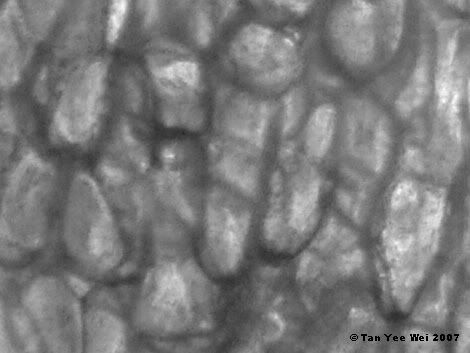
A full-sized crop of the preceding image
The next images might be disturbing to some people. They are closed up images of a fly's various anatomical details, including but not limited to the compound eye, transparent wing, hairy thorax and barbed legs.
Please do not complain that you were eating/drinking tea/having sex and this post made you throw up.
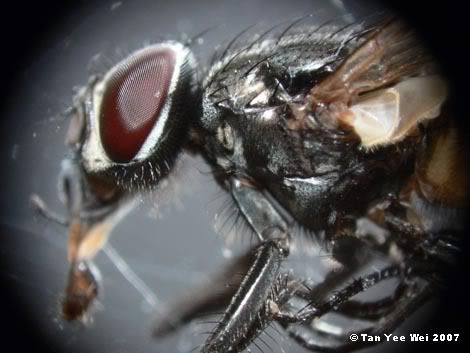
Click here for large size image
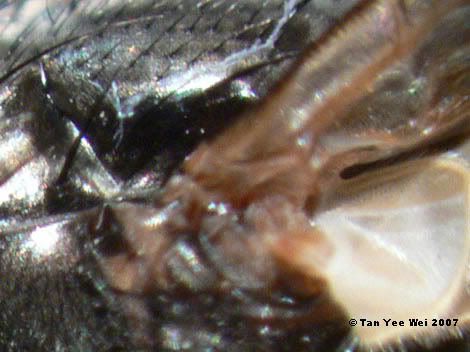
A close up of the wing's joint

Click here for large size image
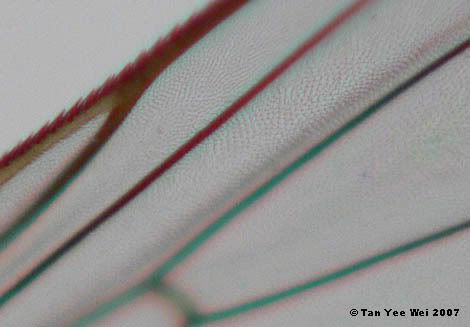
Click here for large size image
The wing's leading edge is serrated
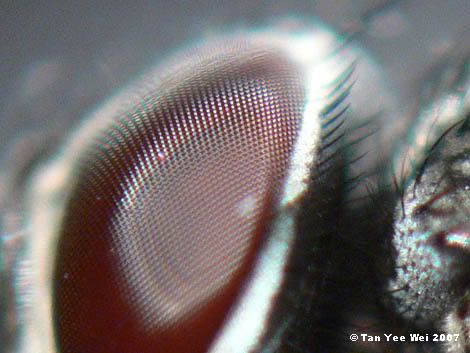
The Eye
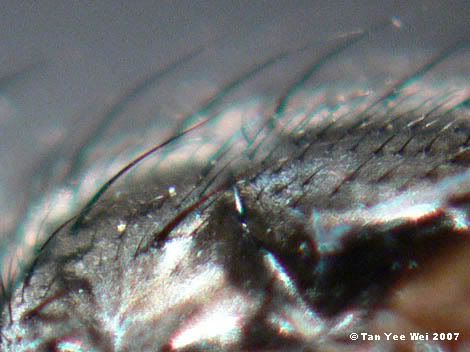
Labels: microscopy, natural science, photographic equipment, photography
Monday, April 09, 2007
Sentience in pure science
Back in the dark days when I was in upper secondary school, our physics teacher was a large and lackadaisical man who by his flexible and whatever attitude allowed us to be slightly rowdier than what other teachers would tolerate.
An incident which remains stuck in my head occurred shortly after a term exam of minor consequence. A few of us were idle standing around the physics teacher as he marked the exam scripts. We openly laughed at some of the classmates’ impotent attempts at salvaging marks, and when the teacher gave each question a score, we would urge him to lower it. Occasionally he did, much to our entertainment.
A particularly hideous phenomenon I noticed on that occasion (but exists even in academia) was the projection of sentience onto mechanical systems. The question of “why does a rolling ball’s speed slow as it rolls up an inclined surface?” was answered with “because the ball is trying to go up the slope but gravity is trying to pull it down.”
By granting the ball and gravity sentience and intention defeats the entire purpose of pure science; it borders the behaviour primitive religions that imbue rocks and celestial objects with spirits and souls. In contrast, pure science does not allow balls and black holes to have intents of their own – otherwise two balls of identical construction would ‘want’ to climb different trees or conquer their own galaxies, behaviours which have not been observed and documented so far.
The construction of pure science partially revolves around the concept of repeatability, a concept which is destroyed by the introduction of sentience. However, it is not for the preservation of the current understanding of science that sentience has been disallowed to be introduced in the understanding of balls; it is because balls have been behaving so consistently that many think that the balls in fact do not have sentience whatsoever.
A nastier example of the projection of sentience is embodied in the common and easy to remember idiom, “nature abhors a vacuum.” Besides the fact that nature not only is given sentience but also emotions, this idiom also wrongfully generalises the behaviour of fluids. A question on HowStuffWorks asks “if nature abhors a vacuum, then why doesn't the vacuum of space suck away all of the Earth's atmosphere?” (The question assumes that nature dislikes a vacuum, but the answer is worse- through a series of logically unsound arguments, it suggests that “nature loves a vacuum.”)
An incident which remains stuck in my head occurred shortly after a term exam of minor consequence. A few of us were idle standing around the physics teacher as he marked the exam scripts. We openly laughed at some of the classmates’ impotent attempts at salvaging marks, and when the teacher gave each question a score, we would urge him to lower it. Occasionally he did, much to our entertainment.
A particularly hideous phenomenon I noticed on that occasion (but exists even in academia) was the projection of sentience onto mechanical systems. The question of “why does a rolling ball’s speed slow as it rolls up an inclined surface?” was answered with “because the ball is trying to go up the slope but gravity is trying to pull it down.”
By granting the ball and gravity sentience and intention defeats the entire purpose of pure science; it borders the behaviour primitive religions that imbue rocks and celestial objects with spirits and souls. In contrast, pure science does not allow balls and black holes to have intents of their own – otherwise two balls of identical construction would ‘want’ to climb different trees or conquer their own galaxies, behaviours which have not been observed and documented so far.
The construction of pure science partially revolves around the concept of repeatability, a concept which is destroyed by the introduction of sentience. However, it is not for the preservation of the current understanding of science that sentience has been disallowed to be introduced in the understanding of balls; it is because balls have been behaving so consistently that many think that the balls in fact do not have sentience whatsoever.
A nastier example of the projection of sentience is embodied in the common and easy to remember idiom, “nature abhors a vacuum.” Besides the fact that nature not only is given sentience but also emotions, this idiom also wrongfully generalises the behaviour of fluids. A question on HowStuffWorks asks “if nature abhors a vacuum, then why doesn't the vacuum of space suck away all of the Earth's atmosphere?” (The question assumes that nature dislikes a vacuum, but the answer is worse- through a series of logically unsound arguments, it suggests that “nature loves a vacuum.”)
Labels: natural science, observations
Friday, April 06, 2007
Strange fiction
I was idly browsing my folder of incomplete and stillborn writings when I came across something I wrote near the end of last year. When I am perturbed sufficiently, I write pointless, jargon filled and technically inspired prose. This is one such example, completed and partially refined.
***
A heavy cloud hung over the western horizon, partially blotting out the setting sun’s orange rays. A light breeze stirred, rustling leaves and stirring dust. Carried by stratospheric currents, the cloud drifted closer.
The cloud was made up of countlessly many question marks. Most of them were infinitesimally small, just a hair larger than Planck-scale. A few, though, were very large. Like magnificent zeppelins of an era past, they coasted through the air silently and buoyantly, painting large black shadows on the ground as they floated by. A close inspection of the question marks’ sizes would reveal that the size distribution adheres to the power law distribution, the very same ethereal distribution found in networks, the Pareto principle, critically stable systems and wealth distribution.
Within the cloud, questions grow, decay, new ones form, answered ones disappear, some fuse, some split. A foam of Planck-scale virtual questions hum around the large question marks, continuously interacting, being absorbed and reemitted.
As the cloud neared, the air filled with a raw energy. The cloud was charged with an electric potential of several million volts and was tethering on the brink of instability.
On the ground, a man stood pondering his future. He has a stake in that cloud; many were his questions.
2 hours ago, a magnetic field abruptly rose from the solar atmosphere. The field lines formed an arch, a massive loop thousands of kilometres above the corona. Interacting with the rest of the sun’s rotating magnetic field, the loop twists and coils haphazardly. The tightly wound magnetic field within the loop spontaneously and violently reconfigures itself into a less strained arrangement, the released energy accelerating a plume of charged particles out of the solar atmosphere.
From above the strastophere, a diluted plume of electrons, protons and helium pierced the atmosphere at 1% the speed of light. Pinpricks of electrons rip through the porous cloud of questions, with trails of virtual-questions being dragged in their wakes.
The sharp tendrils behind the electron trails extended the cloud’s electric field sufficiently to cause a spontaneous discharge. The cloud’s charge of several million Volts dissipate through a luminous arc, cleaving the sky in two and connecting the cloud and the man.
Within 300 femtoseconds, both man and cloud were gone.
A heavy cloud hung over the western horizon, partially blotting out the setting sun’s orange rays. A light breeze stirred, rustling leaves and stirring dust. Carried by stratospheric currents, the cloud drifted closer.
The cloud was made up of countlessly many question marks. Most of them were infinitesimally small, just a hair larger than Planck-scale. A few, though, were very large. Like magnificent zeppelins of an era past, they coasted through the air silently and buoyantly, painting large black shadows on the ground as they floated by. A close inspection of the question marks’ sizes would reveal that the size distribution adheres to the power law distribution, the very same ethereal distribution found in networks, the Pareto principle, critically stable systems and wealth distribution.
Within the cloud, questions grow, decay, new ones form, answered ones disappear, some fuse, some split. A foam of Planck-scale virtual questions hum around the large question marks, continuously interacting, being absorbed and reemitted.
As the cloud neared, the air filled with a raw energy. The cloud was charged with an electric potential of several million volts and was tethering on the brink of instability.
On the ground, a man stood pondering his future. He has a stake in that cloud; many were his questions.
2 hours ago, a magnetic field abruptly rose from the solar atmosphere. The field lines formed an arch, a massive loop thousands of kilometres above the corona. Interacting with the rest of the sun’s rotating magnetic field, the loop twists and coils haphazardly. The tightly wound magnetic field within the loop spontaneously and violently reconfigures itself into a less strained arrangement, the released energy accelerating a plume of charged particles out of the solar atmosphere.
From above the strastophere, a diluted plume of electrons, protons and helium pierced the atmosphere at 1% the speed of light. Pinpricks of electrons rip through the porous cloud of questions, with trails of virtual-questions being dragged in their wakes.
The sharp tendrils behind the electron trails extended the cloud’s electric field sufficiently to cause a spontaneous discharge. The cloud’s charge of several million Volts dissipate through a luminous arc, cleaving the sky in two and connecting the cloud and the man.
Within 300 femtoseconds, both man and cloud were gone.
Labels: compositions, cryptic
